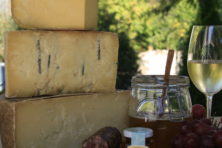The Cheese Insider
- Share
- Tweet
- Pin
- Share
Affinage is a French term, referring to the craft of refining or finishing cheese. It is an old, hands-on process that involves aging a formed cheese until it reaches its optimal ripeness, quality and peak flavor. Many of the artisan cheeses being made today use this art in the aging, or curing process.
What is an affineur? An affineur is the person that cares for the cheese during the aging process; many times it is the cheesemaker, but some cheeses require more care or space than the cheesemaker has available. In some cases the cheese is given to a person, affineur, who does nothing but care for the cheese until it is ready to be sold or delivered to the customer.
There are three elements involved in affinage: temperature, humidity, and time. Cheeses are alive and change with time, continuing to ripen. As they age, many cheeses are brushed, washed and rotated. It is a very time-consuming process, and one the end consumer never sees or most often, even knows about.
The types of cheese best suited for affinage include:
• Naturally-ripened cheeses: These cheeses need nothing more than to be in the right environment, and to be turned or rotated on a regular basis.
• Surface-ripened cheeses: Cheeses that are not ripened internally, typically they are soft and semi-soft varieties. The affinage process generally involves wiping the cheese surface with a wash or brine solution that may contain water, salt, harmless bacteria or yeast, wine or beer.
• Washed-rind cheeses: These cheeses are washed with a solution formulated by the cheesemaker for the desired flavor they wish. The solution can be as simple as a saltwater base with the addition of B-linen culture but can also contain wine, beer, mead or brandy.
The uniqueness of the wash is what gives the cheese the flavor the cheesemaker is seeking.
• Smear-ripened brick cheese: A Wisconsin original, brick cheese goes into an aging room and is constantly rubbed with a strong smelling solution of whey and brine. The longer it is aged, the more aromatic it becomes…hence the term “stinky” cheese. The wild thing is although it may be “stinky” to smell, that does not transfer to the actual taste of the cheese when you put it in your mouth.
• Cave-aged cheeses: The cheeses are often cured in underground caves or in above ground coolers that simulate the conditions of an actual cave, 48 to 53 degrees, and 90 percent humidity. Some cheeses are turned daily, while others may be every three to four days. Some of the cheeses are washed between one to four times a week. They may also be brushed to minimize the mold growth.
I have been in the caves of nearly all our cheesemakers and seen firsthand the incredible work they do to bring us such fantastic cheese.
Source: Wisconsin Milk Marketing Board



